#As in like.. carbon fiber material
Text
Hexweave Cloth in WoW is probably meant to refer to hexes like spells, but I can't help but imagine it all as being triaxially woven so that the pattern of the weave forms hexagons rather than squares, and I'm in danger of giving myself more projects to try and figure out how to do it at that scale
#most of the projects I'm seeing seem to be more like. basket weaving or tiny little samplers with ribbon#And I'm trying to think of how you could scale that up (or down rather?) for yardage#But most of the things I can find for full scale triaxial looms seem to be limited to heavily industrial applications#As in like.. carbon fiber material#The best case I'm seeing for hand weaving is hexagonal or triangular looms that are a couple feet wide#and then that's it that's the size of your fabric#Which isn't good enough!!#watch me get way too invested in this and try to reinvent the wheel (loom) and ignore all the projects I should be working on
0 notes
Text
Just found out the OceanGate sub hull was made with Carbon Fiber???? Can fail under compression with one poorly manufactured air bubble carbon fiber??? Subjective to failure inducing embrittlement at low temperatures carbon fiber???? That carbon fiber????
I am in absolute horrified Awe. Like. I don’t know much about submarines, but I know rockets and we use carbon fiber for hobby rockets and. You can’t?? Make a pressurized vessel out of carbon fiber?? And expect it to survive cyclical loads?? Especially one experiencing temperatures as low as the waters by the Titanic!! Like the polymer matrix would DEFFO experience embrittlement and at MINIMUM crack but more likely would fail catastrophically!! Your threasbold for acceptable cracking would be MINISCULE at that pressure; you couldn’t afford brittle cracking almost at all!!
This article goes into some detail about the safety concerns with the material used and how they were literally brought up and ignored! like. This is the literal scenario they train us for ethics wise in college! Legit the definition! Of when you should put human life before the company!!
Idk it’s just. There’s so much wrong with the situation, but like. To not perform nondestructive testing on the hull?? To ignore visible defects on a supplied material??
So many red flags, so many things that should Never have happened.
#oceangate#titanic#submarine#carbon fiber#materials engineering#engineering ethics#death#i legit gasped when i heard the hull was cf#a break from fandom content for a horrified engineering rant#dont get me started on the titanium in the cf that it sounds like they used
90 notes
·
View notes
Text
all i've learned from this submersible situation is that u could never pay me enough to step foot into the ocean
#also that it was a materials selection nightmare#why are u putting carbon fiber in high pressure environments#it's still a fairly new material compared to other materials used in deep sea operations#and sure it was paired with titanium#but there's a reason why navy submarines and such are made of materials that can deform and huge amounts of compression over multiple uses#i.e. steel and aluminum#also carbon fiber has good tensile strength (pulling it apart) as opposed to compressive strength (pushing on it)#on top of the fact that it's much more brittle than say metals#metals can deform and won't immediately crack under intense pressure#while carbon fiber likely would (there hasn't been enough testing of the behavior of cf under rly high pressures)#the amount of corner cut on that submersible was astounding#i especially feel bad for the 19 yr old on there since he only went to make his father happy :(#ok nerd rant over#wait i didn't mention THE WIRELESS GAME CONTROLLER#U DON'T WANT THAT#EVERYTHING SHOULD BE HARD WIRED TOGETHER#also the viewpoint wasn't even graded to go that deep#viewport*#someone on twt called it a deep sea hubris coffin#and#yeah it kinda was#ashlee's bs
19 notes
·
View notes
Text
i find it funny that even my manager, who would sell anything as long as it wasnt expired, has also given in and has started telling people to not get a specific RayBan frame that we carry. its got tooooo many issues
#1) the edges of the temple legs are sharp and cut into people's ears (thanks carbon? fiber? material)#2) said temple legs are NOT adjustable because the material does NOT bend. you try and it fucking cracks or is permanently broken#3) this frame is TWO HUNDRED AND SIXTY DOLLARS. THE MOST EXPENSIVE FRAME WE CARRY#its not worth it#mara's shit#all of us tell people to avoid that frame like the plague
2 notes
·
View notes
Text
oh god. if i DO manage to get my hands on that flea market cello, im gonna have to actually pick my own bow and everything
#it's STRESSFUL#do i want carbon fiber or wood?? what material should the frog be?? do i want a lightweight or heavyweight bow??#what kind of hair should i be looking for?? what about size?? it's a fuckin MESS#and like... ill probably have to order my bow online. how will i know if the balance is right for me#i won't even know what kind of tone it makes!!! agh!!!!!!!
1 note
·
View note
Text
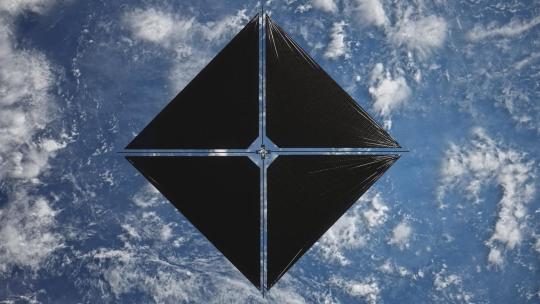
Setting Sail to Travel Through Space: 5 Things to Know about our New Mission
Our Advanced Composite Solar Sail System will launch aboard Rocket Lab’s Electron rocket from the company’s Launch Complex 1 in Māhia, New Zealand no earlier than April 23, at 6 p.m. EDT. This mission will demonstrate the use of innovative materials and structures to deploy a next-generation solar sail from a CubeSat in low Earth orbit.
Here are five things to know about this upcoming mission:
1. Sailing on Sunshine
Solar sails use the pressure of sunlight for propulsion much like sailboats harness the wind, eliminating the need for rocket fuel after the spacecraft has launched. If all goes according to plan, this technology demonstration will help us test how the solar sail shape and design work in different orbits.

2. Small Package, Big Impact
The Advanced Composite Solar Sail System spacecraft is a CubeSat the size of a microwave, but when the package inside is fully unfurled, it will measure about 860 square feet (80 square meters) which is about the size of six parking spots. Once fully deployed, it will be the biggest, functional solar sail system – capable of controlled propulsion maneuvers – to be tested in space.

3. Second NASA Solar Sail in Space
If successful, the Advanced Composite Solar Sail System will be the second NASA solar sail to deploy in space, and not only will it be much larger, but this system will also test navigation capabilities to change the spacecraft’s orbit. This will help us gather data for future missions with even larger sails.

4. BOOM: Stronger, Lighter Booms
Just like a sailboat mast supports its cloth sails, a solar sail has support beams called booms that provide structure. The Advanced Composite Solar Sail System mission’s primary objective is to deploy a new type of boom. These booms are made from flexible polymer and carbon fiber materials that are stiffer and 75% lighter than previous boom designs. They can also be flattened and rolled like a tape measure. Two booms spanning the diagonal of the square (23 feet or about 7 meters in length) could be rolled up and fit into the palm of your hand!

5. It’s a bird...it’s a plane...it’s our solar sail!
About one to two months after launch, the Advanced Composite Solar Sail System spacecraft will deploy its booms and unfurl its solar sail. Because of its large size and reflective material, the spacecraft may be visible from Earth with the naked eye if the lighting conditions and orientation are just right!
To learn more about this mission that will inform future space travel and expand our understanding of our Sun and solar system, visit https://www.nasa.gov/mission/acs3/.
Make sure to follow us on Tumblr for your regular dose of space!
2K notes
·
View notes
Note
Is spider silk being as strong as steel another lie from childhood? Bc you're able to break it pretty easily on accident. Genuinely asking.
spider silk IS actually significantly stronger pound-for-pound than the same amount of steel, but only in one direction! and coincidentally, it's the same exact direction that got a bunch of people killed in a submersible last month.
see, when people talk about the "strength" of spider silk versus steel, they're specifically talking about tensile strength:
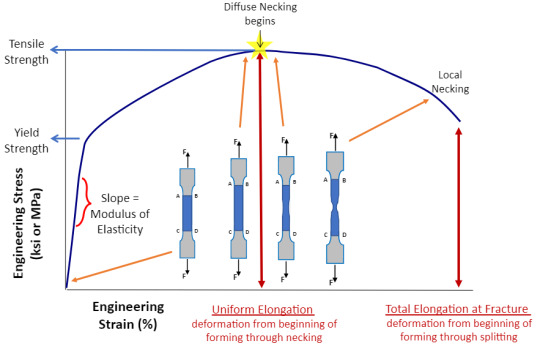
which is specifically the measure of the strength of a material when two forces are pulling at it from the ends, like when a steel cable is holding up a bridge support, or crane cargo:
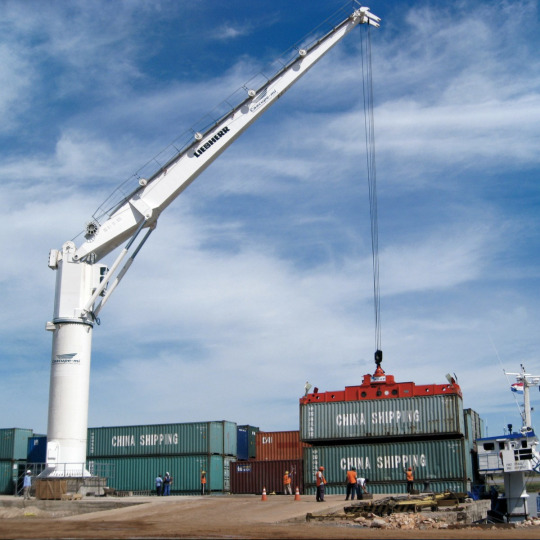
or like when a strand of silk is supporting the entire spider.
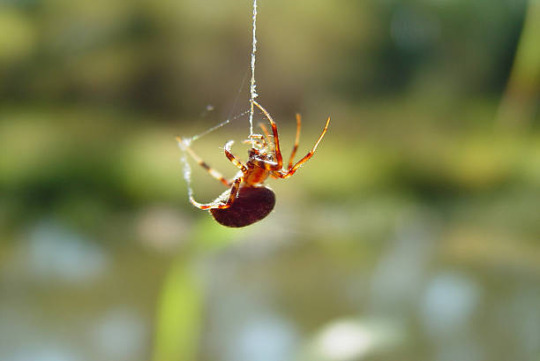
that's tensile strength, baby!
but there's another type of strength that's very important to take into consideration when you're actually building things like bridges and submersibles, and spider silk and similar materials like carbon fiber are absolutely garbage at it! and that's compressive strength.
this is basically the inverse of tensile strength, where instead of being yanked at from both ends, the forces are crushing inwards at the material from both directions instead.

you can expect to see these kinds of forces involved in road surfaces, vehicle engines, and again, submersibles.
now steel and its more competent cousin titanium are fucking GREAT at compressive strength! the harder the outside forces are compressing them, the stronger the metals get.
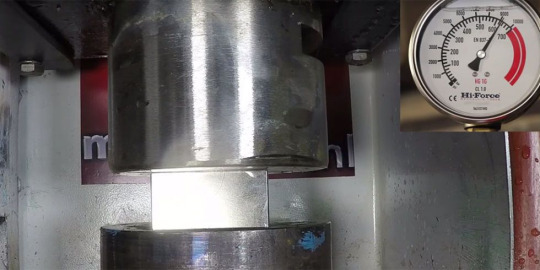
NOT TODAY, FUCKERS
but strand-based materials like spider silk and, again, carbon fiber, are fucking garbage at this. they can take a certain amount of pressure, but each round with compressive forces snaps some of the strands that makes up the material! and those don't grow back, so basically you're just gradually reducing your poor overstressed carbon-fiber hull into a completely useless shell of shattered thread fragments over time as the strands of fiber that actually give it strength die off one by one.

and eventually, something's gotta give! and then people die about it.
this is why, even though spider silk IS stronger than steel in one specific way, we're never going to stop using steel in industrial applications and switch over to spider silk or carbon fiber full time. these materials all have their areas of use, and steel just covers a wider base of applications.
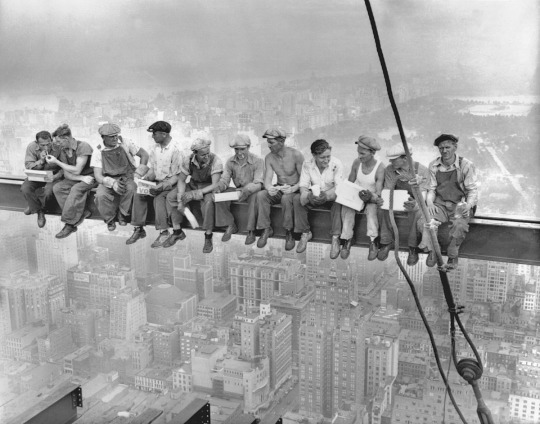
and don't even get me started on shear strength. we'll be here all damn day.
5K notes
·
View notes
Text
On the subject of the Titanic ‘submersible’ that was lost in the deep with all its wealthy tourists— it’s so insane/eerie in hindsight to read this article from the Smithsonian that interviews the CEO Stockton Rush long before the disaster.
Despite the Smithsonian supposedly being an organization that cares about science and truth, and the fact that there were SO MANY obvious red flags from the beginning and so many people criticizing the company…..the article is a puff piece uncritically glorifying the CEO’s obviously terrible submersible project. It compares him in glowing terms to Elon Musk. It is an article about how private ventures like those of Stockton Rush and Elon Musk can and should be the future of the world.
We’ve obviously learned now that there were whistleblowers at the company who were warning for a long time that Stockton Rush’s submersible was unsafe— only to be fired and then sued. It makes sense the submersible was so unsafe, because the CEO in this interview is open about how he has no background in underwater engineering and is annoyed by quote “regulations that needlessly prioritize passenger safety.”
Soon after, the private [submersible] market died too, Rush found, for two reasons that were “understandable but illogical.” First, subs gained a reputation for danger. Working on offshore rigs in harsh locations like the North Sea, saturation divers, who breathe gas mixtures to avoid diving sicknesses, would be taken in subs to work at great depths. It was the world’s most perilous job, with frequent fatalities. (“It wasn’t the sub’s fault,” says Rush.) To save lives, the industries moved toward using underwater robots to perform the same work.
Second, tourist subs, which could once be skippered by anyone with a U.S. Coast Guard captain’s license, were regulated by the Passenger Vessel Safety Act of 1993, which imposed rigorous new manufacturing and inspection requirements and prohibited dives below 150 feet. The law was well-meaning, Rush says, but he believes it needlessly prioritized passenger safety over commercial innovation (a position a less adventurous submariner might find open to debate). “There hasn’t been an injury in the commercial sub industry in over 35 years. It’s obscenely safe, because they have all these regulations. But it also hasn’t innovated or grown—because they have all these regulations.”
The fact that Stockton Rush (who was piloting the submarine when the disaster happened) is on record complaining about the evils of regulations that prioritize people’s safety, and the Smithsonian uncritically regurgitated that rhetoric in their glowing puff piece about how rich tycoons like Elon Musk and Stockton Rush are going to save the world is just…..in hindsight of how everything ended it’s just so much horrible black comedy? It’s like a satire about the dangers of uncritically worshipping the rich.
It is mentioned in the article that Rush chose to make his submersible in a different shape, and with a different (cheaper) material than is usually used for submersibles. The article frames this as a result of daring innovation, and not of negligence/ignorance. This passage in particular, which in context is supposed to portray Rush’s critics as joyless naysayers who were proven wrong by the noble tycoon, is pretty foreboding in hindsight:
Rush planned to pilot the sub himself, which critics said was an unnecessary risk: Under pressure, the experimental carbon fiber hull might, in the jargon of the sub world, “collapse catastrophically.”
And then!!
The exact problem that happened to Titan this weekend, happened on Titan’s very first test voyage to the Titanic! The experimental carbon fiber hull had an issue and it caused communications to break down!
The dive was going according to plan until about 10,000 feet, when the descent unexpectedly halted, possibly, Rush says, because the density of the salt water added extra buoyancy to the carbon fiber hull. He now used thrusters to drive Titan deeper, which interfered with the communications system, and he lost contact with the support crew. He recalls the next hour in hallucinogenic terms. “It was like being on the Starship Enterprise,” he says. “There were these particles going by, like stars. Every so often a jellyfish would go whipping by. It was the childhood dream.”
Both Rush and the article writer treat this as a fun quirky story, instead of a serious safety failure and red flag with his experimental macgyvered regulation-flaunting submersible.
Other highlights from the article include:
Stockton rush saying that if 3/4 of the planet is water, why haven’t we monetized it?
Stockton saying we will “colonize the ocean long before we colonize space”
Lots of weird pro colonialism stuff in general??? This article loves colonialism and thinks it’s cool
Rush saying he plans for this to eventually help find more underwater resources for the US to exploit and profit from
Elon musk comparisons. The article writer does not mention that Elon Musk’s rockets explode and therefore it would be a bad idea to get in one of them, because that would imply it’s a bad idea to get into the submersible
Stockton rush seeing himself as Captain Kirk
The article writer comparing the tourists who plan to join Rush to Englishmen who went on colonialist journeys to Africa as if that’s like, a good thing. So much pro colonialism stuff in this article
So many sentences about Stockton Rush being handsome when he literally just looks like some guy
The article beginning with an editor’s note from years later disclaiming that the extraordinary submersible they’re advertising in this article is uh. It’s now uhhhh
But yeah it really does just bring home how so many organizations that supposedly care about scientific truth or journalistic integrity are willing to uncritically platform propaganda for wealthy CEOS. It’s frustrating how easily people fall for the fake myths that careless wealthy people invent for themselves, and even more frustrating that supposedly respectable institutions will platform irresponsible lies that end up getting people killed.
Rush is such an obvious and simple example of this, and his negligence is “only” killing five people including himself. But to me it feels like a cautionary tale to bear in mind when it comes to uncritical puff piece media coverage of similar “daring tycoon innovations” by people like Bezos or Musk.
#titanic#oceangate#titanic submersible#sorry this is just so fascinating to me#it’s like a parody or piece of satire#if it were in a novel it would feel like the symbolism was too obvious and on the nose
6K notes
·
View notes
Text
what grinds my gears like nothing else is textiles manufacturers greenwashing bamboo/rayon yarn or fabric as though the fact that it's derived from plant material erases the enormously toxic manufacturing process. like the first thing you think of when you think of bamboo yarn/fabric is 'oh it must be made like any other plant fiber' but no!!! that's a semisynthetic fiber that's usually made with carbon disulfide which is extremely toxic to workers and environment both!
and there ARE less destructive bamboo processing techniques you CAN make bamboo fiber the same way you do any other bast fiber theres EVEN a less common chemical process that doesnt do the same harm that viscose rayon does but NO instead we get ~natural fiber~ greenwashing that hides behind the extremely reasonable assumptions people make about plant fibers
I will never ever in my life begrudge people who buy bamboo yarn or for that matter acrylic because (a) goddamn its fucking rough out here (b) I'd be a massive hypocrite (c) the problem is the manufacturers not the individual and (d) sometimes it IS the yarn for the job but I will never stop beating my drum about this bc we! deserve! to know!
#autism.txtile#knitting#yarnblr#gets out soapbox TEXTILES' INCREDIBLE TECHNOLOGICAL ADVANCES & HORRIFYING HUMAN & ENVIRONMENTAL DESTRUCTION CANNOT BE MEANINGFULLY SEPARATED#aiden.txt
1K notes
·
View notes
Note
Ok but imagine 42! Miles with a s/o who's literally the complete opposite of him in terms of aesthetic but she helps him when he's the prowler. Like nobody would expect the sweet, energetic, girl with the "Mabel pines" energy to be the gal in the chair for the prowler and making his weapons and at the same time being his girlfriend. They're a literal force to be reckon with.
Complete opposites but totally work
(I love this and so sorry it took so long but enjoy!)
Mabel Pines!Reader

You guys work very, very well together
I can't even describe it very well but it's like yin and yang
He was absolutely gobsmacked on how smart you actually could be
Because not mean, he thought of you as a sort of airhead for a while
But he actually found it quite cute or adorable on you
But he did find out very quickly that y'all have very, very different aesthetics
To be frank you look like a rainbow threw up on you
While Miles is all gloomy and dark over there
So safe to say you throw some glitter in him and force him to be colorful
He finds it hard sometimes to keep up with your energy
But it good for him
His mama absolutely LOVES you
She sees how much Miles loves you just due to the light you bring into his eyes
You can give this man anything and he will pretend to not like it but raise hell if you try and take it back
You guys proudly watch the news of worried women and men on TV talking about jobs you guys pulled and tryna catch you guys
Y'know those sassy guys we see in Tiktoks?
He's that sassy guy with you when you make him mad or annoyed
Knees facing the other way with his whole body while he side eyes you
But he can't resist you for very long
He actually was quite shocked when he found out you had a little dark side
He always saw you looking on the bright side of things
So you partaking in his Prowler activities, much less MAKING the shit for them, absolutely shocked him
He found it quite hot though I can't lie
You're absolutely right when you're completely different but work so well together
Even Uncle Aaron saw it
He uses you sometimes as a little diversion
A fake damsel in distress might I say
He never actually puts you in danger a you can very much so handle yourself but he's always lurking around the corner in these situations
You are an absolute monster at anything Miles needs
New gloves? Done
New mask? Done
Fucking Ray gun? Why didn't he ask sooner? Here, it's in your bag
You absolutely stick little stickers on his crap as well
You can't help yourself
But he absolutely loves it
You sit in the chair looking all pretty but can turn intimidating real quick as he's sitting on the arm chair
Y'know those scenes where the bad guy asks their "dumb/weird" henchman like
"I have no idea…how about we ask (Name)?"
Those type of scenes and you can come up with the best shit he didn't even think of
Absolutely soul mates
Anyway, enjoy this little scene I made:
Miles breathed heavily, leaning against the wall on the rooftop to the door to go back down to his home. He was dressed as the Prowler, breathing labored from a fight.
Miles tried to breathe the best he could, even succeeding for a moment before his eyes snapped open as he heard the shudder of a phone camera and a flash.
Miles' eyes widened, hand in front of him as the flash died and he saw you standing there, blank faces and camera held out in front of you.
Miles and you stared at one another for a moment, nothing to say at all.
"Is that carbon fiber?" You suddenly spoke up.
"...what?-" Miles blinked, barely able to process this before you almost jumped on him.
"Ooh! How did you make this?!" Miles couldn't even breathe and before he knew, his helmet was in your hands as you went on.
"This material is tough enough but you know I could make a much better one if-" you rambles on, an excitement to your voice Miles knew all to well as you flipped over the mask in your hands
"Wait– hold on." Miles held his arms out, effectively causing a pause in your rant as you stared back at him.
"Y'know who I am…right?" Miles asked, slowly and almost trying to be intimidating.
"Um…the Prowler?" You muttered, utterly confused as you tilted your head, holding the helmet to your chest.
"Yeah?!" Miles exclaimed, eyes wide and hands held out like he was trying to get a point across.
"Mhm. Is this like…a trick question, or…?" You asked, completely unbothered by it all as you looked down at the mask, examining it as you merely glanced up at him.
"No! Just- why are you so calm about this?" Miles asked, shocked as well.
"Well, it's not really shocking. You sorta have the backstory of a villain, anyway." You shrugged, staring dead at him.
"...seriously?"
"Well, kinda. Sorry, is this like a bad time for you?" You asked, still not handing over the mask as you held it over your head, almost trying to put it on.
"No, just, you can't tell anyone about this." Miles said, grabbing the mask to hold it in place and off your head, almost dangerously close to your face.
"I mean, I'm not? But-" you started and Miles almost rolled his eyes at your excited expression.
"I can help you!" You stated, biting your lip in excitement as you almost glowed from the glitter on you.
"Help…me?" Miles raised a brow.
"Yeah! Everyone thinks I'm dumb, but I have dirt on everyone. Everyone. And, not a lotta people notice I'm there so I can get you a lot of info, or like- routes and stuff. I'm also good with my hands."
You went on proudly, Miles looking between you and your hand which held his helmet.
It took a moment, Miles going over it all in his head.
He finally sighed.
Miles opened the door to the stairwell, gesturing inside as your eyes widened in shock before you actually smiled, hurrying inside quickly as you rambled on.
Miles followed after you, a seemingly annoyed expression on his face, but the dust of pink across his cheeks from your smile gave him away.
~~~~~~~~~~~~~~~~~~~~~~~~~~~~~~~~~~~~~~~~~
@mushystrawberries @sweetheartlizzie07 @itstooearly-its3am @Ihavetoexist @kaorussgf @samsketchezz @yas-v @lovelymiaablogss @sussybaka10 @shisuishoe @sairavity @moonlight-rosevine @spectr3inl0ve @najiiix @popeheywardssecretgf @onginlove @sylisan @onginlove
#across the spiderverse#across the spider verse spoilers#across the spider verse x reader#spider man: across the spider verse#into the spiderverse x reader#miles morales earth 42 x reader#miles morales x y/n#miles morales x you#miles morales x reader#miles x reader#earth 42 miles morales#earth 42 miles morales x reader
1K notes
·
View notes
Text
The Real Cost of the Fashion Industry

Atacama Desert, in Alto Hospicio, Iquique, Chile. (source)
The textile industry is destroying the world. The industry is wasting massive amounts of energy and materials, and polluting the air, the ground and the water supplies. It overwhelmingly exploits it's labour and extracts wealth from colonized countries, especially in Asia. I assume we all broadly understand this, but I think it's useful to have it all laid out in front of you to see the big picture, the core issues causing this destruction and find ways how to effectively move forward.
The concerning trend behind this ever-increasing devastation are shortening of trend cycles, lowering clothing prices and massive amount of wasted products. Still in year 2000 it was common for fashion brands to have two collections per year, while now e.g. Zara produces 24 collections and H&M produces 12-16 collections per year. Clothing prices have fallen (at leas in EU) 30% from 1996 to 2018 when adjusted to inflation, which has contributed to the 40% increase in clothing consumption per person between 1996 and 2012 (in EU). (source) As the revenue made by the clothing industry keep rising - from 2017 to 2021 they doubled (source) - falling prices can only be achieved with increasing worker exploitation and decreasing quality. I think the 36% degrees times clothing are used in average during the last 15 years (source) is a clear indication on the continuing drop in quality of clothing. Clothing production doubled between 2000 and 2015, while 30% of the clothes produced per year are never sold and are often burned instead (source), presumably to prevent the returns from falling due to oversupply.
These all factors are driving people to overconsume. While people in EU keep buying more clothes, they haven't used up to 50% of the clothes in their wardrobe for over a year (source). This overconsumption is only made much worse by the new type of hyper fast fashion companies like SHEIN and Temu, which are using addictive psychological tactics developed by social media companies (source 1, source 2). They are cranking up all those concerning trends I mentioned above.
Under the cut I will go through the statistics of the most significant effects of the industry on environment and people. I will warn you it will be bleak. This is not just a fast fashion problem, basically the whole industry is engaging in destructive practices leading to this damage. Clothing is one of those things that would be actually relatively easy to make without massive environmental and human cost, so while that makes the current state of the industry even more heinous, it also means there's hope and it's possible to fix things. In the end, I will be giving some suggestions for actions we could be doing right now to unfuck this mess.
Carbon emissions
The textile industry is responsible for roughly 10% of the global CO2 emissions, more than aviation and shipping industry combined. This is due to the massive supply chains and energy intensive production methods of fabrics. Most of it can be contributed to the fashion sector since around 60% of all the textile production is clothing. Polyester, a synthetic fiber made from oil which accounts for more than half of the fibers used in the textile industry, produces double the amount of carbon emissions than cotton, accounting for very large proportions of all the emissions by the industry. (source 1, source 2)
Worker exploitation
Majority of the textiles are produced in Asia. Some of the worst working conditions are in Bangladesh, one of the most important garment producers, and Pakistan. Here's an excerpt from EU Parliament's briefing document from 2014 after the catastrophic Rana Plaza disaster:
The customers of garment producers are most often global brands looking for low prices and tight production timeframes. They also make changes to product design, product volume, and production timeframes, and place last-minute orders without accepting increased costs or adjustments to delivery dates. The stresses of such policies usually fall on factory workers.
The wage exploitation is bleak. According to the 2015 documentary The True Cost less than 2% of all garment factory workers earned a living wage (source). Hourly wages are so low and the daily quotas so high, garment workers are often forced through conditions or threats and demand to work extra hours, which regularly leads to 10-12 hour work days (source) and at worst 16 hour workdays (source), often without days off. Sometimes factories won't compensate for extra hours, breaching regulations (source).
Long working hours, repetitive work, lack of breaks and high pressure leads to increased risks of injuries and accidents. Small and even major injuries are extremely common in the industry. A study in three factories in India found that 70% of the workers suffered from musculosceletal symptoms (source). Another qualitative study of female garment workers and factory doctors in Dhaka found that long hours led to eye strain, headaches, fatigue and weight loss in addition to muscular and back pains. According to the doctors interviewed, weight loss was common because the workers work such long hours without breaks, they didn't have enough time to eat properly. (source) Another study in 8 factories in India found that minor injuries were extremely common and caused by unergonomic work stations, poor organization in the work place and lack of safety gear, guidelines and training (source). Safety precautions too are often overlooked to cut corners, which periodically leads to factory accidents, like in 2023 lack of fire exists and fire extinguishers, and goods stacked beyond capacity led to a factory fire in Pakistan which injured dozens of workers (source) or like in 2022 dangerous factory site led to one dead worker and 9 injured workers (source).
Rana Plaza collapse in 2013 is the worst industrial accident in recent history. The factory building did not have proper permits and the factory owner blatantly ignored signs of danger (other businesses abandoned the building a day before the collapse), which led to deaths of 1 134 workers and injuries to 2 500 workers. The factory had or were at the time working for orders of at least Prada, Versace, Primark, Walmart, Zara, H&M, C&A, Mango, Benetton, the Children's Place, El Corte Inglés, Joe Fresh, Carrefour, Auchan, KiK, Loblaw, Bonmarche and Matalan. None of the brands were held legally accountable for the unsafe working conditions which they profited off of. Only 9 of the brands attended a meeting to agree on compensation for the victim's families. Walmart, Carrefour, Auchan, Mango and KiK refused to sight the agreement, it was only signed by Primark, Loblaw, Bonmarche and El Corte Ingles. The compension these companies provided was laughable though. Primemark demanded DNA evidence that they are relatives of one of the victims from these struggling families who had lost their often sole breadwinner for a meager sum of 200 USD (which doesn't even count for two months of living wage in Bangladesh (source)). This obviously proved to be extremely difficult for most families even though US government agreed to donate DNA kits. This is often said to be a turning point in working conditions in the industry, at least in Bangladesh, but while there's more oversight now, as we have seen, there's clearly still massive issues. (source 1, source 2)
One last major concern of working conditions in the industry I will mention is the Xinjiang raw cotton production, which is likely produced mainly with forced labour from Uighur concentration camps, aka slave labour of a suspected genocide. 90% of China's raw cotton production comes from Xinjiang (source). China is the second largest cotton producer in the world, after India, accounting 20% of the yearly global cotton production (source).
Pollution
Synthetic dyes, which synthetic fibers require, are the main cause of water pollution caused by the textile industry, which is estimated to account for 20% of global clean water pollution (source). This water pollution by the textile industry is suspected of causing a lot of health issues like digestive issues in the short term, and allergies, dermatitis, skin inflammation, tumors and human mutations in the long term. Toxins also effect fish and aquatic bacteria. Azo dyes, one of the major pollutants, can cause detrimental effects to aquatic ecosystems by decreasing photosynthetic activity of algae. Synthetic dyes and heavy metals also cause large amounts of soil pollution. Large amounts of heavy metals in soil, which occurs around factories that don't take proper environmental procautions, can cause anaemia, kidney failure, and cortical edoem in humans. That also causes changes in soil texture, decrease in soil microbial diversity and plant health, and changes in genetic structure of organisms growing in the soil. Textile factory waste water has been used for irrigation in Turkey, where other sources of water have been lacking, causing significant damage to the soil. (source)
Rayon produced through viscose process causes significant carbon disulphide and hydrogen sulphide pollution to the environment. CS2 causes cardiovascular, psychiatric, neuropsychological, endocrinal and reproductive disorders. Abortion rates among workers and their partners exposed to CS2 are reported to be significantly higher than in control groups. Many times higher amounts of sick days are reported for workers in spinning rooms of viscose fiber factories. China and India are largest producers of CS2 pollution, accounting respectively 65.74% and 11,11% of the global pollution, since they are also the major viscose producers. Emission of CS2 has increased significantly in India from 26.8 Gg in 2001 to 78.32 Gg in 2020. (source)
Waste
The textile industry is estimated to produce around 92 million tons of textile waste per year. As said before around 30% of the production is never sold and with shortening lifespans used the amount of used clothing that goes to waster is only increasing. This waste is large burned or thrown into landfills in poor countries. (source) H&M was accused in 2017 by investigative journalists of burning up to 12 tonnes of clothes per year themselves, including usable clothing, which they denied claiming they donated clothing they couldn't sell to charity instead (source). Most of the clothing donated to charity though is burned or dumbed to landfills (source).
Most of the waste clothing from rich countries like European countries, US, Australia and Canada are shipped to Chile (source) or African countries, mostly Ghana, but also Burkina Faso and Côte d'Ivoire (source). There's major second-hand fashion industries in these places, but most of the charity clothing is dumbed to landfills, because they are in such bad condition or the quality is too poor. Burning and filling landfills with synthetic fabrics with synthetic dyes causes major air, water and soil pollution. The second-hand clothing industry also suppresses any local clothing production as donated clothing is inherently more competitive than anything else, making these places economically reliant on dumbed clothing, which is destroying their environment and health, and prevents them from creating a more sustainable economy that would befit them more locally. This is not an accident, but required part of the clothing industry. Overproduction let's these companies tap on every new trend quickly, while not letting clothing the prices in rich countries drop so low it would hurt their profits. Production is cheaper than missing a trend.
Micro- and nanoplastics
There is massive amounts of micro- and nanoplastics in all of our environment. It's in our food, drinking water, even sea salt (source). Washing synthetic textiles accounts for roughly 35% of all microplastics released to the environment. It's estimated that it has caused 14 million tonnes of microplastics to accumulate into the bottom of the ocean. (source)
Microplastics build up into the intestines of animals (including humans), and have shown to probably cause cause DNA damage and altered organism behavior in aquatic fauna. Microplastics also contain a lot of the usual pollutants from textile industry like synthetic dyes and heavy metals, which absorb in higher quantities to tissues of animals through microplastics in the intestines. Studies have shown that the adverse effect are higher the longer the microplastics stay in the organism. The effects cause major risks to aquatic biodiversity. (source) The health effects of microplastics to humans are not well known, but studies have shown that they could have adverse effects on digestive, respiratory, endocrine, reproductive and immune systems. (source)
Microplastics degrade in the environment even further to nanoplastics. Nanoplastic being even smaller are found to enter blood circulation, get inside cells and cross the blood-brain barrier. In fishes they have been found to cause neurological damage. Nanoplastics are also in the air, and humans frequently breath them in. Study in office buildings found higher concentration of nanoplastics in indoor air than outdoor air. Inside the nanoplastics are likely caused mostly by synthetic household textiles, and outdoors mostly by car tires. (source) An association between nanoplastics and mitochondrial damage in human respiratory cells was found in a recent study. (source)
Micro and nano plastics are also extremely hard to remove from the environment, making it even more important that we reduce the amount of microplastics we produce as fast as possible.
What can we do?
This is a question that deserves it's own essays and articles written about it, but I will leave you with some action points. Reading about these very bleak realities can easily lead to overwhelming apathy, but we need to channel these horrors into actions. Whatever you do, do not fall into apathy. We don't have the luxury for that, we need to act. These are industry wide problems, that simply cannot be fixed by consumerism. Do not trust any clothing companies, even those who market themselves as ethical and responsible, always assume they are lying. Most of them are, even the so called "good ones". We need legislation. We cannot allow the industry to regulate itself, they will always take the easy way out and lie to their graves. I will for sure write more in dept about what we can do, but for now here's some actions to take, both political and individual ones.
Political actions
Let's start with political actions, since they will be the much more important ones. While we are trying to dismantle capitalism and neocolonialism (the roots of these issues), here's some things that we could do right now. These will be policies that we should be doing everywhere in the world, but especially rich countries, where most of the clothing consumption is taking place. Vote, speak to others, write to your representative, write opinion pieces to your local papers, engage with democracy.
Higher requirements of transparency. Right now product transparency in clothing is laughably low. In EU only the material make up and the origin country of the final product are required to be disclosed. Everything else is up to the company. Mandatory transparency is the only way we can force any positive changes in the production. The minimum of transparency should be: origin countries of the fibers and textiles in the product itself; mandatory reports of the lifecycle emissions; mandatory reports of whole chain of production. Right now the clothing companies make their chain of production intentionally complex, so they have plausible deniability when inevitably they are caught violating environmental or worker protection laws (source). They intentionally don't want to be able to track down their production chain. Forcing them to do so anyway would make it very expensive for them to keep up this unnecessarily complex production chain. These laws are most effective when put in place in large economies like EU or US.
Restrictions on the use of synthetic fibers. Honestly I think they should be banned entirely, since the amount of microplastics in our environment is already extremely distressing and the other environmental effects of synthetic fibers are also massive, but I know there are functions for which they are not easily replaced (though I think they can be replaces in those too, but that's a subject of another post), so we should start with restrictions. I'm not sure how they should be specifically made, I'm not a law expert, but they shouldn't be used in everyday textiles, where there are very easy and obvious other options.
Banning viscose. There are much better options for viscose method that don't cause massive health issues and environmental destruction where ever it's made, like Lyocell. There is absolutely no reason why viscose should be allowed to be sold anywhere.
Governmental support for local production by local businesses. Most of the issues could be much more easily solved and monitored if most clothing were not produced by massive global conglomerations, but rather by local businesses that produce locally. All clothing are made by hand, so centralizing production doesn't even give it advantage in effectiveness (only more profits for the few). Producing locally would make it much more easier to enforce regulations and it would reduce production chains, making production more effective, leaving more profits into the hands of the workers and reducing emissions from transportation. When the production is done by local businesses, the profits would stay in the producing country and they could be taxed and utilized to help the local communities. This would be helpful to do in both exploited and exploiter countries. When done in rich countries who exploit poorer ones, it would reduce the demand for exploitation. In poor countries this is not as easily done, since poor means they don't have money to give around, but maybe this could be a good cause to put some reparations from colonizers and global corporations, which they should pay.
Preventing strategic accounting between subsidiaries and parent companies. Corporate law is obviously not my area of expertise, but I know that allowing corporations to move around the accounting of profits and losses between subsidiaries and parent companies in roughly 1980s, was a major factor in creating this modern global capitalist system, where corporations can very easily manipulate their accounting to utilize tax heavens and avoid taxes where they actually operate, which is how they are upholding this terrible system and extracting the profits from the production countries. How specifically this would be done I can't tell because again I know shit about corporate law, so experts of that field should plan the specifics. Overall this would help deal with a lot of other problems than just the fashion industry. Again for it to be effective a large economic area like EU or US should do this.
Holding companies accountable for their whole chain of production. These companies should be dragged to court and made to answer for the crimes they are profiting of off. We should put fear back into them. This is possible. Victims of child slavery are already doing this for chocolate companies. If it's already not how law works everywhere, the laws should be changed so that the companies are responsible even if they didn't know, because it's their responsibility to find out and make sure they know. They should have been held accountable for the Rana Plaza disaster. Maybe they still could be. Sue the mother fuckers. They should be afraid of us.
Individual actions
I will stress that the previous section is much more important and that there's no need to feel guilty for individual actions. This is not the fault of the average consumer. Still we do need to change our relationship to fashion and consumption. While it's not our fault, one of the ways this system is perpetuated, is by the consumerist propaganda by fashion industry. And it is easier to change our own habits than to change the industry, even if our own habits have little impact. So these are quite easy things we all could do as we are trying to do bigger change to gain some sense of control and keep us from falling to apathy.
Consume less. Better consumption will not save us, since consumption itself is the problem. We consume too much clothing. Don't make impulse purchases. Consider carefully weather you actually need something or if you really really want it. Even only buying second-hand still fuels the industry, so while it's better than buying new, it's still better to not buy.
Take proper care of your clothing. Learn how to properly wash your clothing. There's a lot of internet resources for that. Never wash your wool textiles in washing machine, even if the textile's official instructions allow it. Instead air them regularly, rinse them in cool water if they still smell after airing and wash stains with water or small amount of (wool) detergent. Never use fabric softener! It damages the fabrics, prevents them from properly getting clean and is environmentally damaging. Instead use laundry vinegar for making textiles softer or removing bad smells. (You can easily make laundry vinegar yourself too from white vinegar and water (and essential oils, if you want to add a scent to it) which is much cheaper.) Learn how to take care of your leather products. Most leather can be kept in very good condition for a very long time by occasional waxing with beeswax.
Use the services of dressmakers and shoemakers. Take your broken clothing or clothing which doesn't fit anymore to your local dressmaker and ask them if they can do something about it. Take your broken and worn leather products to your local shoemaker too. Usually it doesn't cost much to get something fixed or refitted and these expert usually have ways to fix things you couldn't even think of. So even if the situation with your clothing or accessory seems desperate, still show it to the dressmaker or shoemaker.
If it's extremely cheap, don't buy it. Remember that every clothing is handmade. Only a small fraction of the cost of the clothing will be paying the wages of the person who made it with their hands. If a shirt costs 5 euros (c. 5,39 USD), it's sewer was only payed mere cents for sewing it. I'm not a quick sewer and it takes me roughly 1-2 hours to cut, prepare and sew a simple shirt, so I'm guessing it would take around half an hour to do all that for a factory worker on a crunch, at the very least 15 minutes. So the hourly pay would still be ridiculously low. However, as I said before, the fact that the workers in clothing factories get criminally low pay is not the fault of the consumer, so if you need a clothing item, and you don't have money to buy anything else than something very cheep, don't feel guilty. And anyway expensive clothing in no way necessarily means reasonable pay or ethical working conditions, cheep clothing just guarantee them.
Learn to recognize higher quality. In addition to exploitation, low price also means low quality, but again high price doesn't guarantee high quality. High quality allows you to buy less, so even if it's not as cheep as low quality, if you can afford it, when you need it, it will be cheaper in long run, and allows you to consume less. Check the materials. Natural fibers are your friends. Do not buy plastic, if it's possible to avoid. Avoid household textiles from synthetic fibers. Avoid textiles with small amounts of spandex to give it stretch, it will shorten the lifespan of the clothing significantly as the spandex quickly wears down and the clothing looses it's shape. Also avoid clothing with rubber bands. They also loose their elasticity very quickly. In some types of clothing (sport wear, underwear) these are basically impossible to avoid, but in many other cases it's entirely possible.
Buy from artisans and local producers, if you can. As said better consumption won't fix this, but supporting artisans and your local producers could help keep them afloat, which in small ways helps create an alternative to the exploitative global corporations. With artisans especially you know the money goes to the one who did the labour and buying locally means less middlemen to take their cut. More generally buy rather from businesses that are located to the same country where the production is, even if it's not local to you. A local business doesn't necessarily produce locally.
Develop your own taste. If you care about fashion and style, it's easy to fall victim to the fashion industry's marketing and trend cycles. That's why I think it's important to develop your personal sense of style and preferences. Pay attention at what type of clothes are comfortable to you. Go through your wardrobe and track for a while which clothing you use most and which least. Understanding your own preferences helps you avoid impulse buying.
Consider learning basics of sewing. Not everyone has the time or interest for this, but if you in anyway might have a bit of both, I suggest learning some very simple and basic mending and reattaching a button.
Further reading on this blog: How to see through the greenwashing propaganda of the fashion industry - Case study 1: Shein
Bibliography
Academic sources
An overview of the contribution of the textiles sector to climate change, 2022, L. F. Walter et al., Frontiers in Environmental Science
How common are aches and pains among garment factory workers? A work-related musculoskeletal disorder assessment study in three factories of south 24 Parganas district, West Bengal, 2021, Arkaprovo Pal et al., J Family Med Prim Care
Sewing shirts with injured fingers and tears: exploring the experience of female garment workers health problems in Bangladesh, 2019, Akhter, S., Rutherford, S. & Chu, C., BMC Int Health Hum Rights
Occupation Related Accidents in Selected Garment Industries in Bangalore City, 2006, Calvin, Sam & Joseph, Bobby, Indian Journal of Community Medicine
A Review on Textile and Clothing Industry Impacts on The Environment, 2022, Nur Farzanah Binti Norarmi et al., International Journal of Academic Research in Business and Social Sciences
Carbon disulphide and hydrogen sulphide emissions from viscose fibre manufacturing industry: A case study in India, 2022, Deepanjan Majumdar et al., Atmospheric Environment: X
Microplastics Pollution: A Brief Review of Its Source and Abundance in Different Aquatic Ecosystems, 2023, Asifa Ashrafy et al., Journal of Hazardous Materials Advances
Health Effects of Microplastic Exposures: Current Issues and Perspectives in South Korea, 2023, Yongjin Lee et al., Yonsei Medical Journal
Nanoplastics and Human Health: Hazard Identification and Biointerface, 2022, Hanpeng Lai, Xing Liu, and Man Qu, Nanomaterials
Other sources
The impact of textile production and waste on the environment (infographics), 2020, EU
Chile’s desert dumping ground for fast fashion leftovers, 2021, AlJazeera
Fashion - Worldwide, 2022 (updated 2024), Statista
Fashion Industry Waste Statistics & Facts 2023, James Evans, Sustainable Ninja (magazine)
Everything You Need to Know About Waste in the Fashion Industry, 2024, Solene Rauturier, Good on You (magazine)
Textiles and the environment, 2022, Nikolina Šajn, European Parliamentary Research Service
Help! I'm addicted to secondhand shopping apps, 2023, Alice Crossley, Cosmopolitan
Addictive, absurdly cheap and controversial: the rise of China’s Temu app, 2023, Helen Davidson, Guardian
Workers' conditions in the textile and clothing sector: just an Asian affair? - Issues at stake after the Rana Plaza tragedy, 2014, Enrico D'Ambrogio, European Parliamentary Research Service
State of The Industry: Lowest Wages to Living Wages, The Lowest Wage Challenge (Industry affiliated campaign)
Fast Fashion Getting Faster: A Look at the Unethical Labor Practices Sustaining a Growing Industry, 2021, Emma Ross, International Law and Policy Brief (George Washington University Law School)
Dozens injured in Pakistan garment factory collapse and fire, 2023, Hannah Abdulla, Just Style (news media)
India: Multiple factory accidents raise concerns over health & safety in the garment industry, campaigners call for freedom of association in factories to ‘stave off’ accidents, 2022, Jasmin Malik Chua, Business & Human Rights Resource Center
Minimum Wage Level for Garment Workers in the World, 2020, Sheng Lu, FASH455 Global Apparel & Textile Trade and Sourcing (University of Delaware)
Rana Plaza collapse, Wikipedia
Buyers’ compensation for Rana Plaza victims far from reality, 2013, Ibrahim Hossain Ovi, Dhaka Tribune (news media)
World cotton production statistics, updated 2024, The World Counts
Dead white man’s clothes, 2021, Linton Besser, ABC News
#fashion#fashion industry#sustainability#sustainable fashion#sustainable clothing#environment#climate change#i will be continuing the series of how to see through fashion industry propaganda at some point#i just felt compelled to write this because i feel like people so often miss the forest for the trees in this conversation
491 notes
·
View notes
Text
"Yer starin' again, love."
Soap's smooth, baritone voice called to you in the vastness of your enraptured stare. Subtle memories of a smile returned into the lines of your lips, pulling yourself back into the realm of existence with a languid whisper rolling off your tongue.
"Sorry, John. Still getting used to them."
"Aye. Take it ya like 'em then?"
Your cheeks burned with the unending affection for the man you had grown to love. Gaze lingering on the newly adorned carbon fiber rims surrounding his eyes, drawing ever more attention to the cerulean stare within.
"Yeah. I like 'em."
"Hm. Still getting used to 'em m'self, lass." He muttered, repositioning the frames on the bridge of his nose to regain focus on the writing in his hand.
"Perhaps you need better reading material," you interjected with a cracked smile.
His blue eyes rolled above the black rim like a current over a pebbled stream. His expression accentuated by a prominently arched brow as he laid the morning paper aside for something much more appealing.
"And what would you have in mind, love? Enlighten me."
You bit the inside of your mouth to keep the smart comment at bay. Preferring a more elusive method of enticing him rather than the usual gritty temperament.
"I think you know what I mean, John."
He shook his head with a heavy brow, a drawn out sigh parting through his lips as his fingers grasped at the arm of his glasses.
"Yer 'opless, lass. Y'know that?"
You raised a hand to halt him mid removal.
"No. Keep them on."
Soap paused. His eyes narrowed, brimming with glorious intent with a curl to his lips that sent a shockwave straight to your core.
"A'right. I'll keep 'em on. But if ya break 'em with them thighs, I'm gonnae break yer back."
"Promise?"
His eyes darkened like an incoming storm within the black, polished frames, a distant rumble echoing deep in his chest as you gingerly hiked up your night gown.
"Heid yer weesht"
Rising from his chair to his full stature, a towering mogul of a man as he marched, knelt down, and prepared to please his most adoring fan.
"Is this gonna become an'ther fetish, lass?"
"Don't know yet. Didn't think I had a thing for an old man in glasses until now."
"Old?"
You had to refrain from letting out a laugh as his growing scowl scolded you. Removing it from his features with the sight of your glistening cunt while he brought himself between the valley of your thighs.
"Do yerself a favor an' keep that smart mouth shut fer five minutes, an' let this old man take care a'ya."
Captain MacTavish Masterlist
#soap squad™️#the brainrot of Captain MacTavish#captain mactavish in glasses is doing things to me#captain soap mactavish#captain mactavish#og soap#captain mactavish x you#captain mactavish x f!reader#soap x you#soap x f!reader
207 notes
·
View notes
Text
Materials Engineering starts out super huge and intimidating, with all this promise of understanding the infinite makeup of the world around you.
And then you get to undergraduate senior year and its just. Ah yes, my only two friends. Carbon and Aluminum.
#materials engineering#silicon pops up a lot too#maybe a little Mn and Mg#as a treat#tbh there is more than just that#but between carbon fiber and additive manufacturing#everything just feeds off that#like steel is just Fe-C#i guess inconel is another outlier#nickel gets an honorable mention
9 notes
·
View notes
Text
Kevlar or Сarbon fiber?
Let's discuss in detail what this material is that is sometimes found in RE.

First, let's break down all the instances where this material can be found.
The first time it can be seen in re5, Wesker's clothes are made of this material: coat, and suit. From “Resident Evil 5 Artbook” you can learn in detail what properties the material of this clothing has. It says: “it can deflect common shrapnel and other small shards, but also breathes well enough to keep the wearer from getting sweaty”.


The next time we can see this material is in the CGI RE Vendetta. The inside of Maria Gomez's suit is embroidered with this material.

The last time we could see this material is on the case that Wesker gave to Ada in the DLC Separate Ways.


So, what can we say about this material? Due to the fact that it is found several times, we can state that this material is common and is used as a protection for important objects, such as the contents of a case or a person's body.
In texture it resembles Aramid fabric (Kevlar), which incidentally fits the description of Wesker's clothing perfectly. Aramid fabric is used to make protective clothing and equipment. The main advantages of the material are super strength and a high level of resistance to mechanical impact. Aramid fabric is widely used due to its outstanding heat resistance, i.e. it is resistant to temperatures from 250 to 400 °C. Also, garments made of Aramid fabric have a service life of up to 10 years due to their ability to retain their shape and size. Wesker, as well as Maria Gomez, have worn their clothes made of this material for several years.

Also, this material resembles Carbon fiber in texture and properties, but I doubt it is. Carbon fiber is not used in clothing, it has found use in reinforcing composite materials, in making auto parts, in construction. So it's often some kind of durable object that's not suitable to become clothing.

We can conclude that most likely Wesker and Maria's clothing is made of Aramid fabric, and Wesker's case is covered in carbon fiber. That sounds the most logical.
By the way, note that in real life, neither Kevlar nor Carbon fiber has the same big “checkerboard” texture as Wesker and Maria's clothing and the case coating.


In reality, to see this weave, the fabric has to be zoomed in on many times to see it. This means that it is likely that a different material was actually used in RE, or the weave was deliberately enlarged by the designers to make it more noticeable and aesthetically pleasing.
#resident evil#rebhfun#albert wesker#maria gomez#resident evil 5#resident evil vendetta#resident evil death island#resident evil 4#resident evil 4 remake#cenori's long posts about RE
109 notes
·
View notes
Text


The Aztec Death Whistle ‘The Most Terrifying Sound in the World’
For those who want to celebrate Halloween like it’s 1399: Scientists are sending shivers down the internet’s collective spine by recreating an ancient “Aztec Death Whistle” that’s said to emit the “most terrifying sound in the world.”
The macabre kazoo is detailed in a new video produced by the Action Lab, a group of proud internet nerds who specialize in mind-bending experiments.
“The sound that the death whistle makes innately strikes fear into your heart,” intones presenter James J. Orgill in the clip while holding a 3D-printed version of the instrument.
The Brigham Young University engineering grad then plays an audio clip of the scream machine, which evokes a bloodcurdling, bansheelike shriek resembling a sound effect from a haunted house attraction. (We dare you not to jump!)
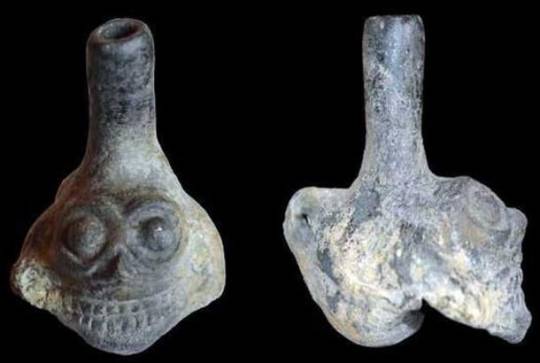
Orgill points out that this is not a “human scream” but rather the sound emitted by the replica of a skull-shaped artifact originally discovered in Mexico City in 1999 by archaeologists.
It was reportedly found clutched in the hand of a headless skeleton in a temple dedicated to the wind god Ehecatl — one of many sites where the Aztecs conducted human sacrifices.
Initially thinking it was a toy, per Orgill, scientists didn’t blow into it until 15 years later, whereupon it emitted a terrifying sound.
“‘It was a startling discovery because it sounded like a screaming human,” said the burgeoning YouTube star, who dubbed it the “most terrifying sound in the world.”


The Aztecs were able to create this nightmarish noise by modeling the death whistle after the human larynx.
When the user blows into the instrument, the wind divides in two, producing oscillating sound waves that bounce around a large chamber before leaving via a second hole.
While the purpose of the instrument remains unclear, experts have several theories, with some believing this fright flute was used to scare enemies in battle.
Others postulate that the whistle was a defense talisman used to ward off evil spirits during a sacrificial victim’s journey to the afterlife.
In order to resurrect this symphony of screams for our listening “pleasure,” Orgill blew into different Tim Burton-esque whistles that were 3D-printed by US tech firm HeyGears.



All told, they made the raptor larynx from “Jurassic Park” sound like a kazoo.
No 3D printer, no problem: Interested parties can buy their death whistles on Amazon, which offers duplicates made of materials ranging from resin to carbon fiber.
Many advertise how closely their decibels match that of the most bone-chilling human screams.
By Ben Cost.
#Aztec Death Whistle#The Aztec Death Whistle ‘The Most Terrifying Sound in the World’#Tlatelolco#mexico city#the wind god Ehecatl#ancient artifacts#archeology#archeolgst#history#history news#ancient history#ancient culture#ancient civilizations#aztecs#aztec history#aztec mythology#aztec culture#aztec gods#aztec empire#aztec art
228 notes
·
View notes
Text
Fashion waste manifests at three stages in the value chain: during the production process where surplus raw materials accumulate; in warehouses where excess buffer stocks settle; and in landfills where post-consumer waste mounts. While the instant fashion model does likely reduce buffer stocks (although the companies don’t share these data to validate their claims), it’s hyper-dependence on fossil fuel-based polyester summed with the short half-life of its cheap clothing causes consequential environmental damage at the other stages of the process.
Instant fashion’s popularity overlaps with the surge in plastic as a fashion input. Prior to 2000, natural fibers (such as cotton and wool) were the primary inputs to clothing. However, as fossil fuel producers have come under pressure from the growth of renewables, growth in plastic supply has proved a welcome offset with the fashion industry serving as a reliable customer. Cheaper, more readily available, and with some preferred properties (e.g. quick-drying, wrinkle-proof, durable, ability to “take” color, and more), synthetics have powered the growth of activewear and instant fashion.
While consumers have benefited from lower prices, the negative impacts of synthetics are an environmental scourge. Energy used to produce plastics is often fossil fuel-intensive leading to increases in carbon emissions. During a plastic garment’s useful life, it sheds microplastics into waterways that end up in the food supply, as do excess concentrations of hazardous chemicals. A recent Greenpeace investigation found that 15% of Shein’s products contain concentrations of hazardous chemicals that breach E.U. regulatory limits. Finally, it takes hundreds of years for cheap synthetic shoes and shirts to decompose, all the while emitting methane and further contributing to climate change. (It’s important to note that even producing clothing with natural, untreated fabrics impacts the environment; the most sustainable option is to produce and consume less.)
76 notes
·
View notes